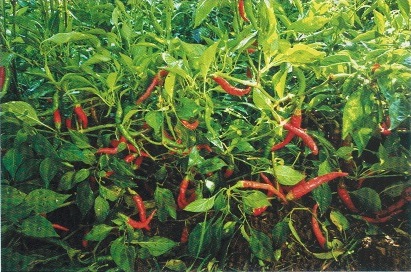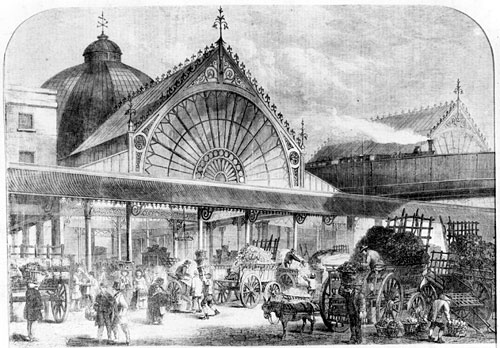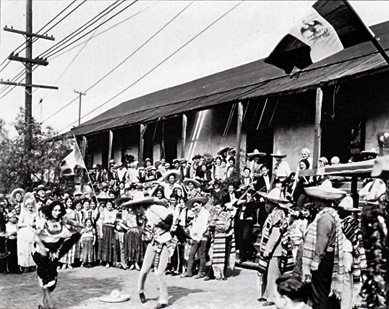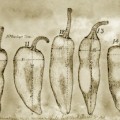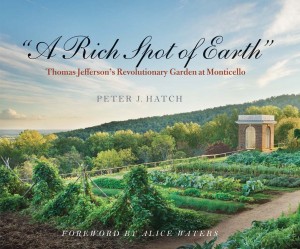 Editor’s Note: This excerpt from Peter J. Hatch’s book, “A Rich Spot of Earth”: Thomas Jefferson’s Revolutionary Garden at Monticello, is reproduced by permission of Yale University Press (New Haven: Yale University Press, 2012, 145-148). Order it from Amazon.com here.
Editor’s Note: This excerpt from Peter J. Hatch’s book, “A Rich Spot of Earth”: Thomas Jefferson’s Revolutionary Garden at Monticello, is reproduced by permission of Yale University Press (New Haven: Yale University Press, 2012, 145-148). Order it from Amazon.com here.
By Peter J. Hatch
Jefferson grew various forms of Bells, Bullnose, sweet, and cayenne pepper (Capsicum annuum), as well as Texas bird pepper (Capsicum annuum var. glabriusculum). His documented sewing of cayenne pepper seed at Shadwell in 1767 is one of the earliest references to this form of Capsicum in North America. Later, in the 1812 “Calendar,” “Major,” “cayenne,” and “Bullnose” (marked by a crinkled, noselike appendage on the blossom end) were planted in adjacent rows in square IX. The Texas bird pepper, obtained from Dr. Samuel Brown of Natchez through acquaintances near San Antonio, was among Jefferson’ most exciting introductions. Jefferson planted bird pepper seed in the garden and with a dibble in flowerpots, and relayed the seed to Bernard McMahon in 1813. Green (also called Bell and Bullnose) peppers appear in the Jefferson family manuscripts as additions to tomato pickles and gumbo soup, while cayenne peppers were added to Virginia Randolph Trist’s tomato soup and Septimia Meikleham’s salad dressing. The Monticello family physician, Dr. Dunglison, prescribed a red pepper gargle to relieve the sore throats of Jefferson’s granddaughters. Culinary historian Karen Hess called the use of hot peppers in traditional Virginia cooking “highly skilled and discrete.”
The motley tribe of Capsicum annuum are New World natives that were often described and illustrated in sixteenth- and seventeenth-century European herbals. Swiss herbalist Leonard Fuchs depicted a long, red cayenne pepper in De Historia Stirpium in 1542 and discussed a block-shaped sweet pepper. John Gerard reviewed three principal sorts, and Richard Bradley listed twenty varieties in 1728. In an early edition of The Gardener’s Dictionary, Philip Miller said that peppers were “of no great use in England” despite extolling “the wholesomest Pickles in the World” made from bell-shaped peppers. By 1768 he was recommending peppers chiefly for ornamental gardens and flowerpots but also praised the cake-like pepper pots made in the West Indies that reputedly relieved flatulence.
Peppers may have been brought into North America by coastal traders or slaves born in the West Indies, where European explorers described the use of hot peppers to enliven the native dishes. Travelers described Jamaican Indians pickling bell-shaped peppers in the 1600s. Swedish botanist Peter Kalm observed “guinea peppers” and “piment” in gardens near Philadelphia in 1748 and Albany in 1749. He was impressed by the versatility of this “spice” when pickling cucumbers, flavoring stews, and preserving peppers with salt and vinegar in bottles. The North Carolina Moravians, immigrants from Pennsylvania, brought “Spanish peppers” to Salem as early as 1759. John Randolph in his Treatise around the Revolution and Gardiner and Hepburn in The American Gardener (1804) briefly allude to planting peppers for pickling. “Indian Peppers” were planted by Orange County’s Francis Taylor in 1791 and 1792; William Faris grew cherry peppers in Annapolis in 1799; and Lady Jean Skipwith mentioned peppers in her Prestwould garden in southern Virginia around 1800. McMahon’s seed house offered eight Capsicum varieties around 1804, but they were called “Annual Flowers” and sold as ornamentals. Pepper seed was found only occasionally on urban lists of the early 1800s. William Booth of Baltimore, for example, sold three varieties of Capsicum for the flower garden in 1810.
The Texas bird pepper is a pretty plant: a tidy, compact mound of rich green foliage capped with petite, sparkling red peppers. Native to northern Mexico and southwest Texas, where it is known as Chiltepin or Chiltecpin, this species is the wild ancestor of many of our cultivated chile peppers. Texas bird peppers were used to make pepper vinegar, pepper sauce, and pickles and were the main ingredient of pepper pots. Jean Andrews, in Peppers: The Domesticated Capsicums, reports that “originally, the Nahuatl [Aztec] word meaning flea was applied [to the bird pepper] because of the similarity in size and bite.” In Mexico, she continues, the flavor is described as “arrebatado,” an expression that means “although it is extremely hot the sensation disappears easily and rapidly.’” Chiltepins are still harvested in the wild and sold in Mexican markets, though native colonies of bird peppers in Texas are becoming rare.
In letters to Jefferson, Dr. Brown noted that Spaniards and American Indians used bird pepper as Europeans do salt. He said it had potentially important medicinal qualities, particularly for “disorders of the alimentary canal,” and noted that “a tablespoon of the pods will communicate to Vinegar a fine aromatic flavor.” Brown added, “The Americans…make a Pickle of the green Pods with Salt &…I find this taste growing so fast that it will soon become as essential to my health as salt itself.” Jefferson was excited by the possibilities and wrote to Brown how, if it proved hardy, the bird pepper would be “a valuable addition to our gardens.” He also exclaimed on the initial shipment of seed, “Planting is one of my great amusements.” Typically reticent about assuming the full responsibility for preserving Brown’s bird peppers, Jefferson forwarded seed to McMahon, to whom he wrote, “They will be more likely however to be preserved in your hands.” And oral history tradition credits McMahon with a central role in popularizing the species throughout southeastern Pennsylvania, where the potted pepper plants serves as a winter table ornament or as windowsill plants.

